Creative Residencies
2017/2018
The Compañía Nacional de Danza launched its Fourth call for contenders in its Creation Residency initiative
This initiative aims to facilitate emerging choreographers a space in which to work and experiment while promoting their creations through the communication platforms put at their disposition.
Guest choreographers
-
Manuela Barrero
DLCAOS
‘ Z È B R E ‘
Proyecto Residente Compañía Nacional de Danza 2018
Dirección / coreografía: Manuela Barrero
Intérpretes: Manuela Barrero / Davicarome
Fotografía: Jacobo MedranoMANUELA BARRERO DLCAOS
Graduated in Art History (U.C.M) specialized in Contemporary Art, Manuela Barrero studied classical dance (Real Conservatorio, Escuela Profesional de Danza de Madrid) following her training in Berlin and Paris.
After working from 2007 to the present in the company LOSDEDAE in the artistic team, as a performer and assistant director, she began her career as an independent creator. She directs the company dlcAos, a project in which the encounter of visual arts, audiovisual, literature, dance, thought, characterizes each creation. With dlcAos she would like to defend the truth of a resurrected and strong dance, created in a dignified space that dignifies it and makes it beautiful for the spectator, not only on stage, but beautiful from its genesis.WHAT IS ‘ Z È B R E’
‘ Z È B R E ‘ is the colloquial French term for ‘weirdo’. It is also associated, in an affectionate and ironic way, with people endowed with a high emotional, sensitive capacity. I associate it, moreover, with the social incomprehension that this, surprisingly, generates. Emotional and intellectual incommunication that provokes in the zebra a state of permanent MELANCOLIA. z è b r e ‘ is inspired by geniuses of the history of universal art, whose biographies and works, are for me external symptoms of the ‘pathology’ that seems to be ‘being different’. Leonardo, Borromini, Anivale Carraci …. They are the ancestors of our contemporary zebra, and the proposal is to express and communicate it through the language of dance. The project is a deep need to call the elusive inspiration. zè b r e ‘ is common solitude, is to claim the different as the essence triggering the rapprochement between different human beings, in a culture that imposes the homogeneity of non-criteria. It is to provoke an embrace of the unknown. It is a reflection on the concept of ANAMORPHOSIS (projection of the form outside of itself) applied to dance.
Using these effects on the very physicality of the dancers, I would like to express the deforming force of the melancholic gaze, its instability, and even inaccuracy, on many occasions. -
Martín Chaix
CND PROJECT: ALIVE
Music In Vivo for String Quartett, II, from Raphaël Cendo – Serenade No. 10 in B flat major KV 361 “Gran Partita” from W.A. Mozart Length ca.
10 minutes
Dancers: 2 women and 2 men.
Cast to be decided later.Eventual collaborators to be included later
SYNOPSIS: Contrasting Mozart’s delicate Serenade No. 10 in B flat major KV 361 with the rough and tense In Vivo from the French composer Raphaël Cendo I wish to explore different aspects of body’s relation between 4 individuals. In this creation process I will also pursue some researches on pointe work and its range of possibilities.
BIOGRAPHY
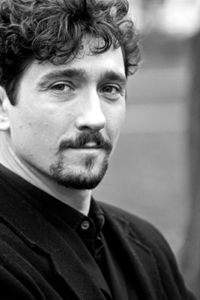
Martin Chaix was born in 1980 in Albi (France), where he began his classical ballet training in 1986.
In 1993 he was accepted at the École de Danse de l’Opéra National de Paris where he studied until 1999 and directly joined the Paris Opera Ballet (dir. Brigitte Lefèvre).
In 2006 he was offered a soloist position at the Leipzig Ballet (dir. Paul Chalmer) experiencing a whole new repertoire and taking part in new creations. Finally,
in 2009 he became a member of the Ballett am Rhein Düsseldorf Duisburg (dir. Martin Schläpfer).
His repertoire as a dancer included choreographies from Rudolf Nureyev, Pina Bausch, Marco Goecke, Uwe Scholz, Édouard Lock, Mats Ek, Hans van Manen, Jiří Kylián and Martin Schläpfer among others.
Since 2015 he is working as a freelance choreographer.
Martin Chaix began choreographing in 2006 for the “Danseurs Chorégraphes” evening at the Paris Opera Ballet and pursued later on with different independent projects and “Young Choreographers” evenings, most notably for the renowned Noverre-Geselschaft evening with the Stuttgart Ballet.
Very soon he received numerous invitation to work with different companies such as the Leipzig Ballet, the Saarland State Theatre Ballet, the Croatian national Ballet in Split and the Ballet am Rhein Düsseldorf Duisburg among others.
Along with different choreographic projects he is also doing some short films and photographies. One of his work has been selected for the One Minute Film Festival in Amsterdam in 2013. -
Carla Diego
PLANGĔRE
Choreography and Direction: Carla Diego Luque
Performers: Claudia Boch Fernández, Maddi Ruiz de Loizaga Goikoetxea and Carla Diego.
Photographs and Videos: Teaser – Marta Diego L
Photographs – Elías Aguirre
Wardrobe: Gemma Espinosa.
Contact: Carla Diego Luque +34 607 63 24 63 Carla.Diegolu@Gmail.Com
Short Film Premiere: Cuerporomo 2017This project is born from an interest in the investigation of the body and movement as well as their joint expression. Developed mainly from the study of different images and a theoretical research, it seeks to make through dance and its physical manifestation a dramatic and poetic discourse of the ritual of mourning focusing on the figure of the mourners.
Starting from different references “p l a n g ĕ r e” begins a search process to define a physicality, expressiveness and aesthetics marked by this ritual of mourning leaving the dance to exert a transformative power for the body and mind to travel through it and make visible and physical the manifestation of grief.
“Atended, llamad a las plañideras, que vengan; buscad a las más hábiles en su oficio; que se apresuren, que vengan y hagan sobre vosotros sus lamentaciones; caiga de vuestros ojos el llanto y manen lágrimas vuestros párpados”
“La comedia salvaje”, José Ovejero. -
Le Doute
THE LONGEST NIGHT
Synopsis: The longest night arises as a meditated vomit because we needed to investigate the interaction of our bodies in movement in a dramatic way and inevitably urged the conflict. A physical conflict, aggressive and yet choked with fragility.
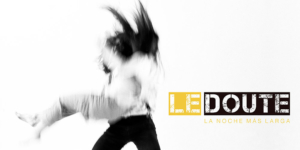
ARTISTIC AND TECHNICAL SHEET:
Performers: Carlos Beluga and Elisa Forcano
Original creation: Carlos Beluga y Elisa Forcano
Music: Serch Geval
Lighting: José Ramírez
Photography: Álvaro Serrano Sierra
Video: Álvaro Serrano Sierra Álvaro Serrano Sierra
Production company: Le Doute
Art Direction:
Carlos Beluga and Elisa Forcano -
Carmen Fumero
UN POCO DE NADIE
Choreography: Miguel Ballabriga, Carmen Fumero with the collaboration of Indalecio Seura.
Performers: Indalecio Seura, Miguel Ballabriga y Carmen Fumero
Music: Iván CebriánSynopsis: Un poco de nadie tells the story of some of us. It talks about trying and not succeeding. Of the anonymous and of being nobody, because a somebody was once a nobody who wanted and did it.
SHOW DOSSIER
Un poco de nadie is a proposal that was born with the motivation of giving importance to the fact of not being nobody.
It is a meeting point between three anonymous characters, a parenthesis in the path of any of us, where the search for our own identity and the encounter with failure are the protagonists.
-
Cía. Marcos Y Marco
THE PARK
The Marcos Y Marco Company is an ensemble of artists who find in contemporary dance one of its many forms of expression. It was formed in 2010 and is based in Marseille (France). Its director and choreographer is the artist Marcos Marco (Santander), his choreographies have participated in numerous festivals and international stages such as France, Spain, Germany, Italy, China, Morocco, Australia, Switzerland, Brazil. Currently his artistic research is structured by several fundamental elements: risk, naturalness, humor, poetry, and the absurd.
He takes his greatest inspiration from details, using them as a common denominator in his works, often being their nexus. The natural movement is the raw material of the composition, the artist’s characteristic language is found in this movement without artifice and honesty.Marcos Y Marco Company presents its new project: The Park
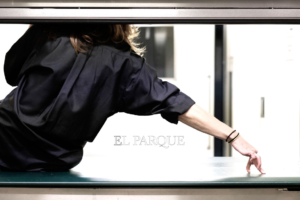
Parks are places where ideas intertwine, where situations are exchanged, where looks weigh and criticism of the unknown becomes absurd, places where chance recreates and invents the world.
In this project we intend to expose THE PARK as a meeting place where we can investigate the behaviors of its followers through a trip to the memory.
To find a refuge in anonymity, to escape from monotony, to reduce the habits of the passers-by to simple ephemeral amusement, to look for connections in silence to find a common language where the performers move between emotions and ensemble energies. A group search where to find its own message, singular and defined.
-
Cristian Martín
SER
SYNOPSIS: I imagine a body subject to doubt and indecision, which coexists with the haste of those who want to arrive and with the calmness of those who know how to wait. A nonconformist, brave man, who faces fears, hits, finds and is also wrong. Free in the search for limits in his own dance, without ties, full of nuances, styles and forms. Being imaginary, being that celebrates life through dance.
(next translation)ARTISTIC SHEET:
Original idea, choreography and interpretation: Cristian Martín
Artistic direction and choreographic orientation: Daniel Doña
Lighting Design: Álvaro Estrada
Original Music: Pablo Martin Jones
Pre-existing music:
Sonada De Adios ( Hommage a Paul Dukas)/ Joaquín Rodrigo
El Chuli and Dr. Kelly / Tino di Geraldo
The Here and After/ Jun Miyake and Lisa Papineau
Árbakkinn/ Ólafur Arnalds & Einar Georg Einarsson
Fandangos de Atapuerca/ Fetén Fetén Fetén
Study for Player Piano(II) / Ólafur Arnalds
Video and photography: Beatrix Molnar
Costume designer: Gabriel Besa
Set design: Daniel Doña -
Alejandro Molinero
ADM
A young team, but with great separate trajectory, joins on this occasion to form the score of this show. However, there are several reviews from both the public and the press, which endorse the good result of the work of this young but talented company.
Directed by Alejandro Molinero, former dancer of the National Ballet of Spain, Molinero en Compañía in his short but intense career has already stepped on the stages of theaters as illustrious as the Campoamor in Oviedo and participated in festivals as important as the Jerez or the Madrid Flamenco Festival.Alejandro Molinero & the CND. ADM Project
-
Muriel Romero
STOCOS INSTITUTE
The Marriage of Heaven and Hell is a choreographic work based on the novel of the same name by William Blake that combines dance, electroacoustic composition, interactive technology and cognitive science in a scenic format.
Description
The central core of Blake is the restoration of the union of apparently irreconcilable opposite pairs, because, as the poet said “without opposites there is no progress”. On the one hand, there is the virtuous clarity of techno-scientific rational thinking (heaven, logos) and on the other, the perverse and overwhelming creative forces of imagination and instinct, which emerge from body energy (hell, mythos).
“Blake’s original work defies genres by organically combining a great variety of elements: from illustrations, poems, parodies, an original mythology, a political anthem or religious manifests, to an entire theory of perception and several descents into the underworld. In our scenic vision, these elements emerge from the body of the dancers in the form of audible entities and visual imagery developed using high technology: models of artificial intelligence and sound synthesis connected in real time to the movements of the dancers.
The coupling between the bodies on the stage and the interactive digital technology extends the body energy of the dance to other sensory modalities such as acoustics and visual imagery. The proposed work is bridging a gap between abstract techno-scientific thinking and the concrete experience of the body”, the Stocos Institute explains.
The work analyses expressive aspects of body movement, such as energy, fluidity, symmetry or impulsivity, translating them (in real time) into audible and visual digital abstractions. The Stocos Institute transforms the scenic space into a reactive environment which springs from the body activity of the dancers. It explores the limits of choreographic imagination and creates an augmented reality of dance.
This project uses technology designed for the development of dance in the European Project WhoLoDancE, part of the Information and Communication Technologies (ICT) programme under Horizon 2020 (H2020), of which the Stocos Institute is a beneficiary partner.
ABOUT INSTITUTO STOCOS
Artificial intelligence, biology, mathematics, and experimental psychology can be danced. The expansion of the body energy of dance to other sensory modalities, thanks to technology, is the field of research of choreographer and dancer Muriel Romero and composer Pablo Palacio. Romero, who began her career with choreographers such as Forsythe or Jiří Kylián, teamed up with Pablo Palacio to found the Stocos Institute, from whence they analyse and develop the interaction between gestures, sounds, and visual imagery. They use technology to develop dance. They investigate three-dimensional movement on a stage on which bodies interact with audible and visual entities. Fruit of its own imagination, the Stocos Institute has produced a series of scenic works that act as an artistic dissemination of their research. Their work, for example Acusmatrix, Catexis, Stocos, Double Bind, Neural Narratives1: Phantom Limb, Neural Narratives2: Polytopya or Piano & Dancer speak in this new language that they have invented.
The theoretical body that Muriel Romero and Pablo Palacio generate is studied in conservatories and universities all over the world. They have participated in pioneering European research projects such as WhoLoDancE, Metabody, and D.A.N.C.E. They have also been collaborating since 2010 in the development of Motion Composer, a technology oriented toward the interaction between body and sound for people with disabilities.
CREDITS
Direction: Pablo Palacio and Muriel Romero
Coreography: Muriel Romero
Music: Pablo Palacio
Starring: Fabrice Edelmann, Clyde Emmanuel Archer, Katerina Humenyuk, Arnau Pérez, Lucía Estévez Almenzar, Gabriella de Alteriis, Teresa Garzón and Aina Canela
Interactive visual simulation: Daniel Bisig
Software and technology: Daniel Bisig, Pablo Palacio and Infomus Casa Paganini
Light: Juan Carlos Gallardo
Costumes: Stocos Institute
Production: Pablo Palacio
Coproduction: Naves Matadero – Centro Internacional de Artes Vivas, Teatro Museo Universidad de Navarra
With the support of: Comunidad de Madrid, EU ICT H2020, Compañía Nacional de Danza, Teatros del Canal, Hebel Halle (Heidelberg, Alemania), Infomus-Casa Paganini- University de Genova (Génova, Italia) and Institute for Computer Music and Sound Technology of Zurich -
William Sánchez
WANDERLUST
WANDERLUST is the third part of the trilogy KALA (Sanskrit for “time”), with which the inclusive dance company SZENE 2WEI concludes its cycle of contemporary dance pieces on various aspects of the term “time”. The names of the first two pieces are TARUN (Sanskrit for “timeless”) and #ATME.
WANDERLUST presents the encounter of the human body with nature as a possibility: starting from a present, with which fast-pace, artificiality and alienation are associated, this encounter opens the way to a promising future.
Future and nature – how do both fit together? The contemporary dance piece WANDERLUST? poses exactly this question. What does the future of nature, the nature of the future look like? The third and last part of the KALA trilogy attempts to bridge between past, present and future. Whether it is global warming, natural disasters or the problematic disposal of nuclear waste – the wish to surpass one’s own limits has led humanity to create monsters that only now become visible and palpable. The elements have lost their balance. But how to deal with this? How to become one again with a nature from which we already seem to have largely alienated ourselves? WANDERLUST? plays with future predictions and produces visions. It asks questions and looks for answers. This piece is an invitation as much as it is an incitement. To face the monsters, develop ideas and first and foremost to never lose one’s wanderlust.
Pedagogic & Artistic director: Timo Gmeiner
Choreographer & Artistic director: William Sánchez H.
Dance: Anne-Hélène Kotoujansky, Eiji Takeda, Fuuko Shimazaki, Jörg Beese, Matthieu Bergmiller, Mukdanin Phongpachith Ricarda Noetzel
Music & Composition: Tim Bücher
Costume, Scenography & Light: Clément Debras
Workshops: Anne-Hélène Kotoujansky, Jörg Beese, Mukdanin Phongpachith
Editorial work: Kristina van Kempen
Video & Photo: Paul Meuth
Graphic Design: Pavlina Boneva
Assistant: Didier Vergel
Stage management: Mercè Mayor
Pictures: Paul Meuth -
Fabián Thomé
Y ö Y
Direction and choreography: Fabián Thomé
Original music: Park Woojae
Original idea: Fabián Thomé % Ignacio Urrutia
Dance: Pau Aran, Carlos Fernández, Fabián Thomé
Dramaturgy, Photography, Video: Ignacio Urrutia
Costumes: Germán Cabrera
Lighting: Víctor Colmenero
Production: Alexei Issacovitch
Duration: 20 min.
Premiere on November 15, 2018, at the De Warande Theater, in Turnhout (Belgium).Three interrelated creatures inhabit a common space where vibration and sound transform the landscape. Exploring the connections with nature, the mysticism of a tree interrogates man on his own path forward. In Amazonian language, “YöY” refers to the forest where dreams take place.
Created for 3 dancers and 1 musician, YöY is part of a trilogy with “umbra” and “entre sombras”, in which Fabian Thomé explores the contradictory relationships between man and mother earth.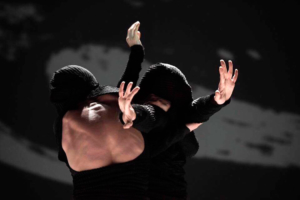
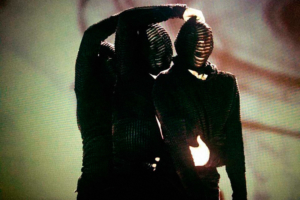
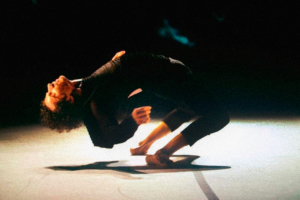
Collaborators: De Warande Theater, Turnhout (Belgium); Fundición, Bilbao; Compañía Nacional de Danza, Madrid.
FABIÁN THOMÉ DUTEN
CARLOS FERNÁNDEZ
PARK WOOJAE
IGNACIO URRUTIA
PAU ARAN



































